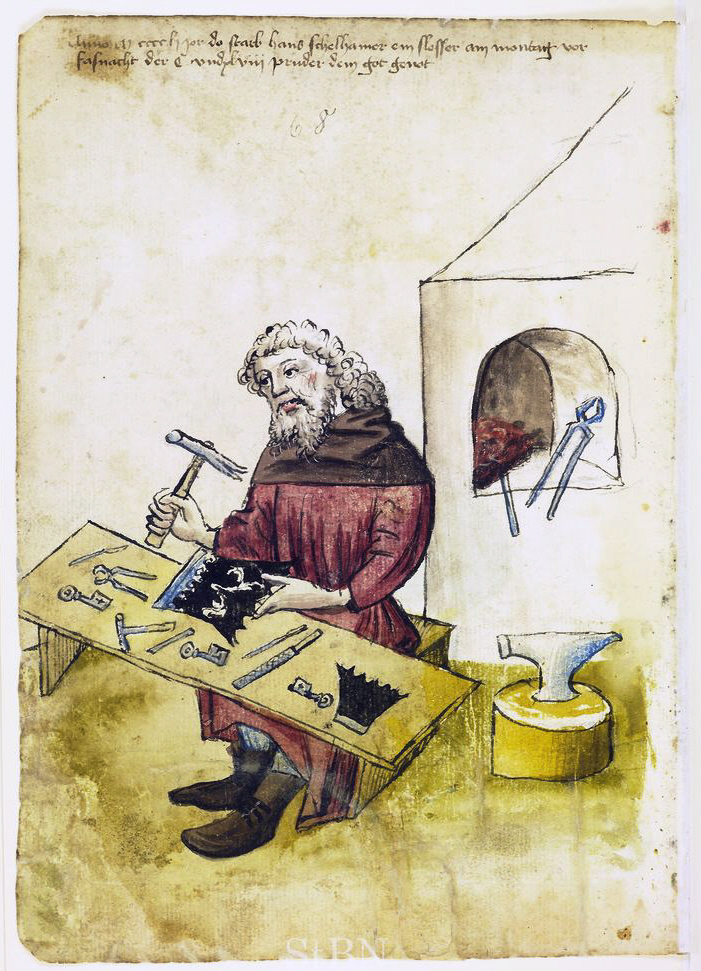The following is an excerpt (pages 472-482) from Ancient and Medieval History (1944) by Francis S. Betten, S.J. Although some information may be outdated, the Catholic historical perspective it provides remains pertinent. Use the link at the bottom of post to read the previous/following pages. Use the Search box above to find specific topics or browse using the Resources tab above.
CHAPTER XLI
MEDIEVAL CITIES
CHARACTER OF THE CITIES
604. The origin of the cities has been alluded to repeatedly. In the former Roman provinces there had remained some of the old communities which carried on their municipal life as best they could. This was in particular the case in Italy and southern France (§ 402; for Germany see § 549). Later on human habitations clustered around the convents and the residences of the bishops and kings. In the beginning these settlements remained under the complete control of the lord of the land, the king or his vassal. Soon they obtained special privileges, such as the exclusive right of holding a market for certain districts. Exemption from the lord’s court of justice, and a greater or less amount of self-government followed.

From a sixteenth-century copper engraving, showing the summons to surrender.
Many and sometimes all of the inhabitants possessed fields in the neighborhood. In fact, a large number of the cities thus created always remained to some extent agricultural. But commerce, carried on on a larger or smaller scale, as well as every kind of handicraft and professional pursuit, stamped all the cities with a quite peculiar character. The increase in money (§ 602) gave a new impetus in the same direction. Thus there arose a division of labor between the town and its rural environs, the latter furnishing the fruits of the fields and the town offering the products of industry and the merchandise imported from elsewhere.

MEDIEVAL TOWN HALL OF OUDENARDE, BELGIUM
605. External Appearance of the City. — The mean cottages of the country folk gave way to the comfortable and even stately homes of the sturdy townsmen, and the palaces, stores, offices, and warehouses of the merchants. Imposing town halls and other public buildings, and large and splendid churches, further contributed to mark the difference between the country and the city.
For their safety the townsmen would surround their cities as the nobles did their castles with lofty stone walls and deep moats. Access could not be had except through the well-fortified gates. The citizens themselves were obliged to military service. By turns they mounted guard at the gates or on the high towers of the wall — at least when times were critical; though ordinarily, in cities which could afford it, these duties were intrusted to a few paid officers. The gates were locked at night. During the day no one was admitted unless he gave the men on duty satisfactory assurance of his unobjectionable character.
The space inclosed by the walls had to be utilized to the utmost. Hence the streets were narrow and dark. They were nearly always crooked, because the city had grown spontaneously, without much planning. Sewerage and sanitation in general left much to be desired. Nor were the thoroughfares lighted during the night.
The number of inhabitants was much smaller than the renown of many a famous city would lead us to expect. There were some really large cities in Italy, one or another of which could claim more than a hundred thousand people. Some German towns went beyond twenty thousand. But few places anywhere had more than seven thousand. Until 1500 England had only two towns with more than twelve thousand — London and Bristol.
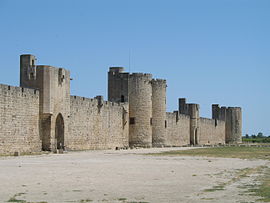
606. Organization was the watchword of the Middle Ages. The adage, “+United we stand, divided we fall,” has never been better understood or more systematically carried into effect. Wherever there were people with the same inclinations, aims, and interests, religious or secular, some kind of gild (guild, society, confraternity) was sure to arise. The number of these gilds was incredibly large. Yet there was no confusion, partly because of the definiteness of their aims and purposes, partly because all were under the active control of the ecclesiastical and civil authorities.
607. I. The religious gilds were somewhat like our own confraternities and sodalities and pious societies. But on the whole they showed their religious spirit more actively in common practices of piety and in the exercise of charity toward members and non-members. Each had its peculiar devotions and religious festivities. But almsgiving, — from funds collected by the members or from endowments established permanently by benefactors, — the care of the sick, the burial of the dead, and the providing of Masses for deceased members were common to all.
These features, however, were found in the secular gilds as well, because the people could not conceive of any organization which would refuse to profess itself Christian. The greatest event in the yearly round of public religious practices was the participation in the Corpus Christi procession. ( The gilds took a prominent part in the performance of the popular religious dramas. Of these there were two kinds, the miracle plays, which enacted events taken from the Bible or from lives of saints; and the morality plays, which presented in allegorical form the great truths which ought to govern the life of Christians. Some of these plays have survived, for instance the famous Everyman, which was given some years ago in most cities of America. It brings out most forcibly the vanity of all earthly possessions. The performances took place in the open air, and there was of course no charge for the spectators.)
608. II. The craft gilds were unions of artisans — weavers, shoemakers, glovers, tanners, and so on. York, a small English city of some three thousand people, had fifty such gilds. Cologne had eighty.
Three grades of workers were distinguished according to their skill in handicraft: masters, journeymen, and apprentices. The master alone might set up a shop in which he himself with one or more journeymen and apprentices worked at his craft. It was a diminutive factory, in which the factory owner himself was a worker. His journeymen commonly, and his apprentices always, lived in his house and ate at his table like members of his family. “The master must so faithfully and loyally teach his apprentice that he can one day answer for it to God.” “He must take his apprentice to church, and with zeal bring him up in honesty and fear of God, as if he were his own child.”
When the stipulated time of the apprenticeship was over, the apprentice became a journeyman, and began “journeying” to other towns in order to perfect himself in his trade and see the world. Some years later he presented to the gild officers his masterpiece, that is, some piece of work in the line of his particular craft, to show his competency. If it was accepted, he was admitted as master to full membership in the gild.
The gilds were formed by the masters and journeymen, while the apprentices were considered its wards. The real control of gild affairs was in the hands of the masters. But the traveling journeyman enjoyed the protection of the gild in every city where he happened to be occupied. It was greatly conducive to a good understanding between employers and employees, that both belonged to the same organization. (In some cities this advantage was lost by the formation of separate journeymen’s gilds, which, like the unions of our own times, consisted of employees only. Strikes, too, were not of infrequent occurrence in the Middle Ages.)
The gilds had their gild houses, some of which were quite sumptuous buildings. Here took place the business meetings and the social gatherings and jollifications. Gild life generated a strong corporate feeling, a pride in the honor of handicraft, and a desire to turn out work which would be a credit both to the workman and to the profession. The craftsman knew there were other men greater and more powerful than he. But he envied them not. According to Divine Providence the workman, too, was a necessary part of the human family; without him the world could exist as little as without the king. And handicraft had been sanctified by the God-Man Himself.
The gild had its patron saint, on whose festival the members in a body attended High Mass, often in their own chapel. Commonly there was a grand procession. A banquet and merrymaking took up the afternoon. Nor were the poor forgotten on such occasions. At Kiel twelve poor people were fed, “and a good piece of beef and a loaf of bread given to twelve poor students.”
The gild was based upon the Christian principles of justice and charity. Every member had the right to share in the supply of raw material of any other member by refunding the cost, and all were bound to follow the same methods in the sale of their products. The price fixed by the gild secured the rights of both producer and customer. (Times have changed since the gilds governed the relation between workman and employer. Our tables and chairs are no longer produced in the craft shop, where a master worked side by side with his journeymen and apprentices. The owner of our furniture factory is no longer on familiar terms with his numerous workmen. Commonly he hardly knows them. The old gild relation cannot be revived except where there is still a sufficiently large number of craftsmen of the old type. Generally speaking we must try to secure by some other method the results formerly obtained by the gilds. Above all it must ever be kept in view that according to the will of God workers and employers are not enemies but friends, neither of whom can get along without the other. The principles which guided the medieval gilds in fixing the amount of wages and prices are still in force and ought to bring about the same result. In his famous encyclical, On the Condition of the Working Classes, Pope Leo XIII sets forth in what manner workingmen’s societies should be organized in our modern times.) If a member died poor, the gild paid a pension to his wife and even gave dowries to his daughters. “We shall be repaid by the good God, Who has repaid many.”
609. III. The merchant gilds were established for the purpose of obtaining those business advantages which could be secured only by united action. Though, like the craft gilds, essentially of a secular nature, they embodied not only the economic but also the religious and charitable features which were practically common to all such organizations. On the continent they were of a more aristocratic character than in England. The craft gilds, conscious of their own strength, here and there engaged with them in bloody contests for political privileges in the government of the cities.
It was chiefly due to the activity of the gilds, religious and secular, that “there was practically no unrelieved poverty in the cities during the later Middle Ages. The specter of the modern proletariat, wretched, debased, with no definitely recognized claim upon any social group or institution, had no counterpart in the municipal life of that time.” Catholic Encyclopedia, III, page 599.
610. Decline of the Gilds. — The rise of princely despotism about and after the beginning of the sixteenth century, and the religious disintegration induced at that time by the Reformation, greatly contributed to the decline of the gilds. In many places on the continent the gilds practically became benefit societies for a limited number of masters’ families and their associates. In some localities, however, gild life retained much of its ancient vigor until well into the nineteenth century.
THE CITIES AS STATES
611. Political Position of the Cities. — The town elected its own officers, and prescribed their powers. Offenses committed within it were tried in its own courts, and were punished by ducking in water, fines, flogging, mutilation, or death. Some of the continental towns inflicted cruel penalties. The town officers, together with the gilds, supervised all industry, in particular the making and selling of articles of food, such as bread, ale, wine, etc. They provided against famine by keeping supplies of grain in the cities’ warehouses. They even made regulations for the dress of the several classes, to prevent extravagance. They waged wars on one another, or concluded special treaties regarding trade privileges. Southampton had formal agreements with seventy other English towns. Within twenty years London sent out three hundred letters on such matters to the officials of ninety different towns. On the continent such city leagues were more pronouncedly of a political character. We have already noted the. powerful Lombard League, which fought against Barbarossa (§ 559).
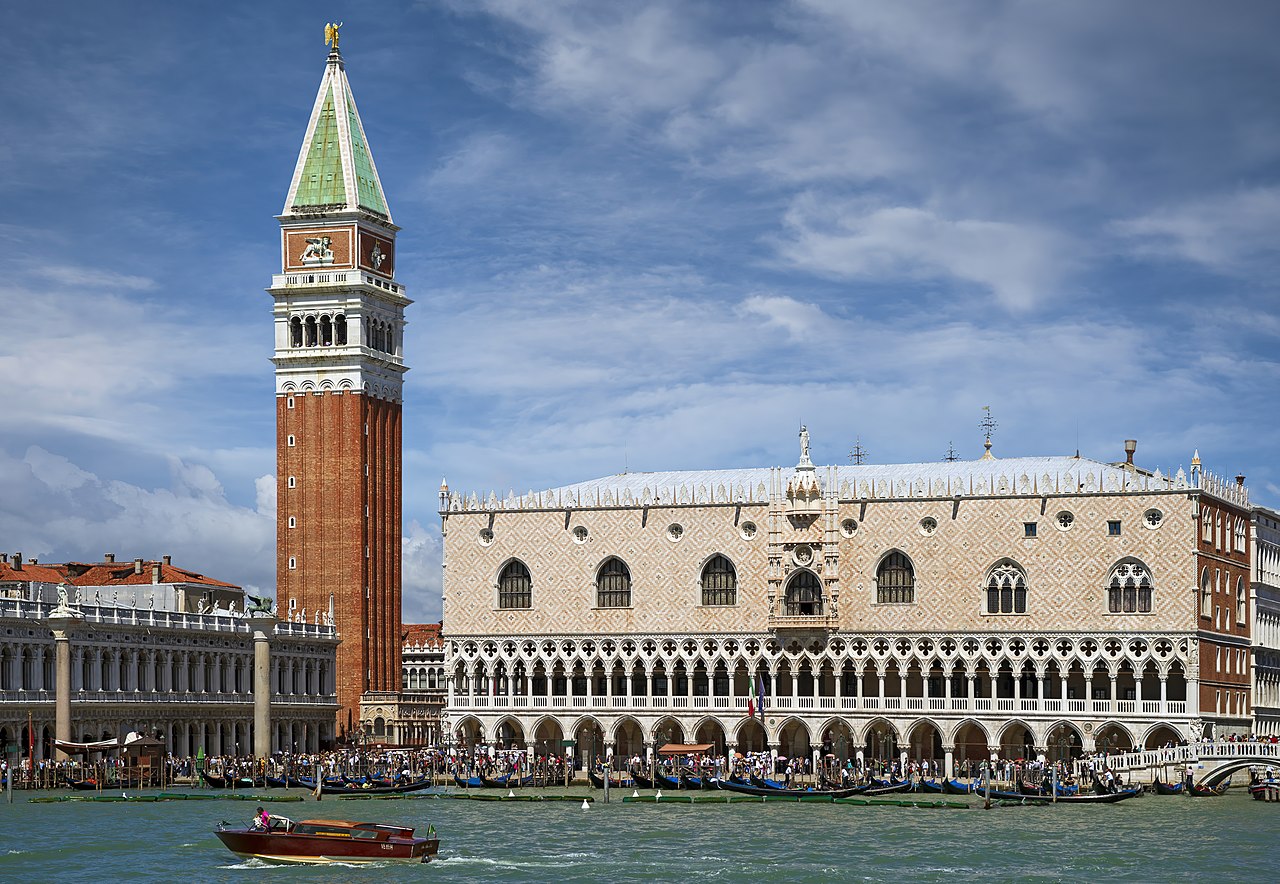
Residence of the doge (duke), the president of the Republic of Venice.
In England the development was slower than on the continent. The cities found the royal power more firmly established, and they never possessed the independence which was found in many continental cities. But the “Cinque Ports,” a league of five towns on the Channel, was able to wage war on its own account with French and Flemish cities. (See also §§ 509, 526, and 534.)
In France the southern towns which had grown from old Roman municipalities (§ 402) were in the beginning almost independent. The systematic increase of the royal power (§ 544) encroached upon them to such a degree that by 1400 their early liberties had entirely vanished, and all the French cities were ruled by royal officers.
Northern Italy. — After the imperial power had almost disappeared, the cities grew enormously in wealth, power, and independence, and were practically sovereign (§ 569). Venice (never under the emperor) and Genoa retained their position as sovereign republics until the days of the French Revolution. Many other cities fared differently. In the incessant wars between town and town, able generals found opportunities to become, first the most prominent men, then the rulers of their fellow citizens. In this way, after a long period of free city life, there appeared dukedoms and other principalities in northern Italy instead of the ambitious municipalities. Chief among these were the dukedoms of Milan under the families of the Visconti and Sforza, and Mantua under the Gonzagas. Later on the Medici held a similar position in Florence.
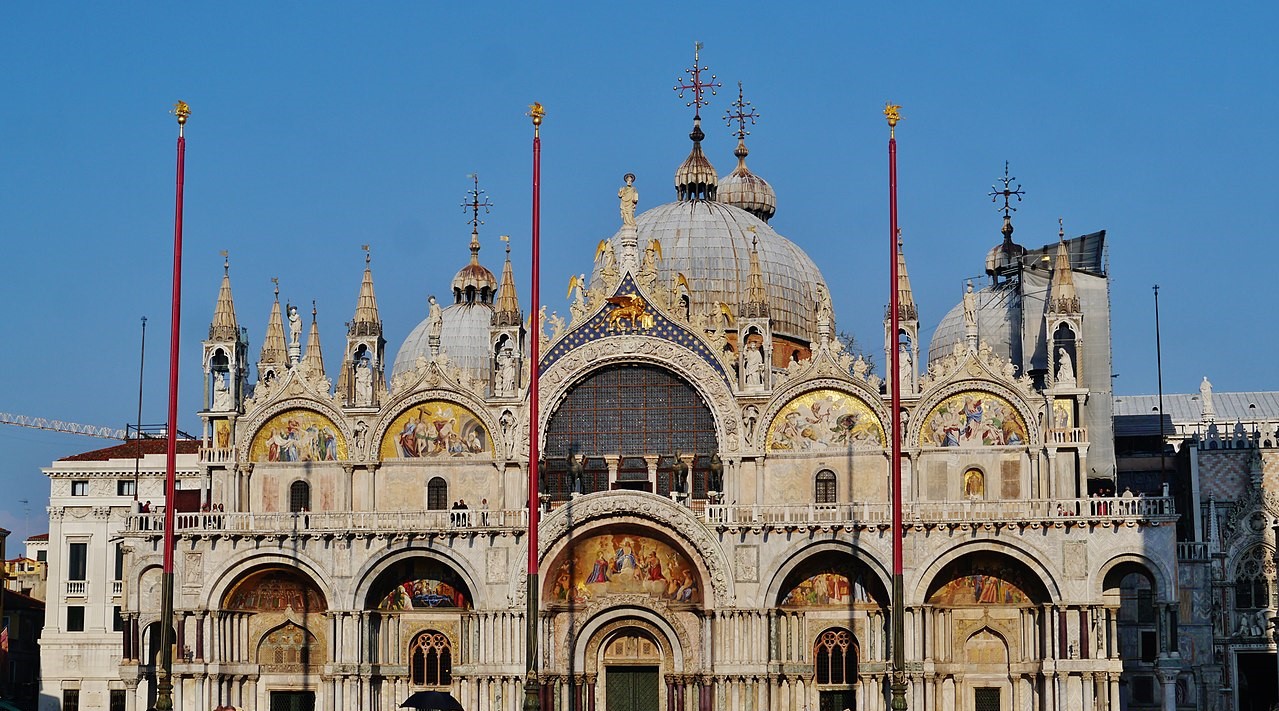
The present building, which replaced an older one, was erected in 976. Its style is a mixture of the Byzantine and the Romanesque (see § 625). Compare with the picture on pages 313 and 386.
612. In Germany the cities rose to be a great political power. They obtained their privileges partly from the king, partly from the vassal lords, the bishops included. Some fifty cities gained freedom from all control of subordinate princes, and became directly subject to the king (or emperor) alone. As “free and imperial cities” they were the equals of the princes in rank. They kept this position until the times of Napoleon I, i.e., the beginning of the nineteenth century.
Like the cities in other countries the German towns frequently combined in city leagues, chiefly to secure safe transit for their commerce by land and sea. Important and mighty were the Rhenish League and the Suabian League, and more so than all the rest combined, the Hansa.
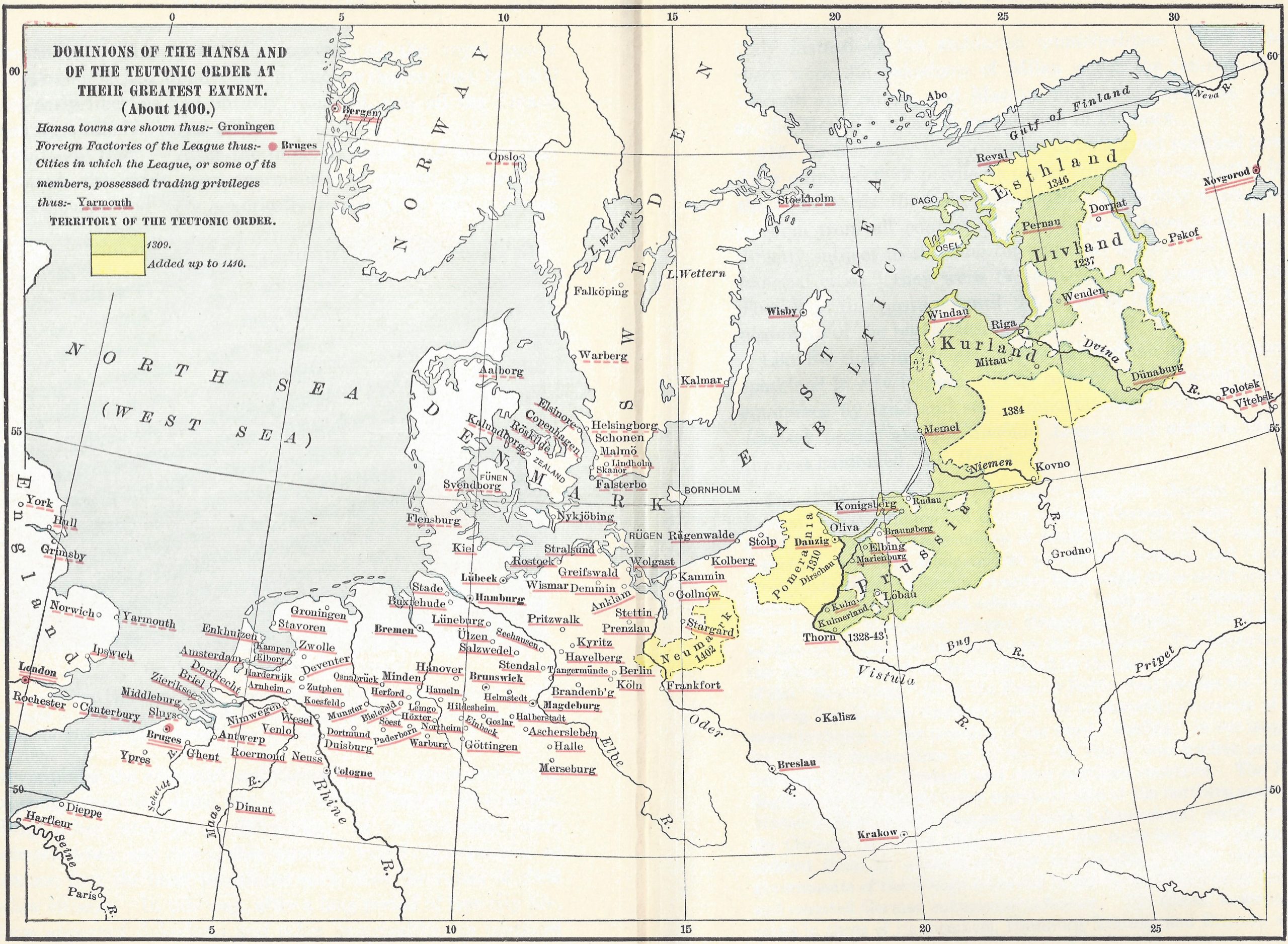
The Hanseatic League (“Hansa,” — an old German word for “union”) was composed of eighty northern German towns. It grew, about 1300, out of earlier unions of small groups of cities; and it was organized to protect trade against pirates and robbers, and to secure greater advantages in foreign countries than single cities could secure for themselves. It established colonies, or “factories,” in foreign cities, as in London, Novgorod, Bergen, Bruges, and Wisby. The Hanseatic settlement in London was known as the Steelyard. The importance of the Hansa in English trade is indicated by the fact that the coin (pound) of the “Easterlings” (from the East, or Baltic, Sea) became the “pound sterling” in English currency; and the trustworthy character of their wares is shown by the meaning of the word “ sterling ” in our language. By friendly transactions or by war, the Hansa won trading privileges from the kings of England and other northern countries. The Hansa flag floated over nearly every merchant ship of the northern seas. The Hansa declined partly because of internal dissensions; partly because the German princes in whose territory the cities lay grew jealous and ordered them to discontinue their membership; partly because the governments of the foreign countries in the north gained more strength and resented German commercial influence. The Hansa, however, still exists in three of its members, Hamburg, Lubeck, and Bremen, which, in 1871, entered the new German Empire on the footing of sovereign states.
613. Conclusion. — For a time it almost seemed as if the future of Europe belonged to the enterprising cities and not to the kings and their larger states, so mighty were the city leagues. We may regret that the ascendency of these thriving little commonwealths declined, and we cannot but disapprove of many of the conditions which brought about this decline. Had their power kept increasing, however, it would have broken up larger national life and reduced all Europe to fragments like the powerless city states of ancient Greece.


